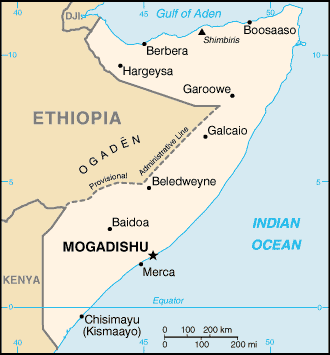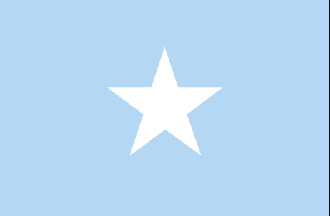
|
Somalia
Background:
The Siad Barre regime was ousted in January 1991; turmoil, factional fighting,
and anarchy have followed for twelve years. In May of 1991, northern clans
declared an independent Republic of Somaliland that now includes the
administrative regions of Awdal, Woqooyi Galbeed, Togdheer, Sanaag, and Sool.
Although not recognized by any government, this entity has maintained a stable
existence, aided by the overwhelming dominance of a ruling clan and economic
infrastructure left behind by British, Russian, and American military
assistance programs. The regions of Bari and Nugaal and northern Mudug comprise
a neighboring self-declared autonomous state of Puntland, which has been
self-governing since 1998, but does not aim at independence; it has also made
strides towards reconstructing a legitimate, representative government, but has
suffered civil strife in 2002. Puntland disputes its border with Somaliland as
it also claims portions of eastern Sool and Sanaag.
Location:
Location: Eastern Africa, bordering the Gulf of Aden and the Indian Ocean, east
of Ethiopia.
Area: Total: 637,657 sq km, water: 10,320 sq km, land: 627,337 sq km.
Area - comparative: Slightly smaller than Texas.
Land boundaries: Total: 2,340 km, border countries: Djibouti 58 km, Ethiopia
1,600 km, Kenya 682 km.
Coastline: 3,025 km.
Climate and Terrain:
Climate: Principally desert.
Terrain: Mostly flat to undulating plateau rising to hills in north.
Natural resources: Uranium and largely unexploited reserves of iron ore, tin,
gypsum, bauxite, copper, salt, natural gas, likely oil reserves.
People:
Population: 8 ,025,190.
Ethnic groups: Somali 85%, Bantu and other non-Somali 15% (including Arabs
30,000).
Religions: Sunni Muslim.
Languages: Somali (official), Arabic, Italian, English.
Government:
Government type: No permanent national government; transitional, parliamentary
national government.
Capital: Mogadishu.
Economy overview:
Economy - overview: Its deep political divisions are driving Somalia's economic
fortunes. Economic life continues, in part because much activity is local and
relatively easily protected. Agriculture is the most important sector, with
livestock normally accounting for about 40% of GDP and about 65% of export
earnings, but Saudi Arabia's recent ban on Somali livestock, because of Rift
Valley Fever concerns, has severely hampered the sector. Somalia's small
industrial sector, based on the processing of agricultural products, has
largely been looted and sold as scrap metal.
Statistics:
Telephones - main lines in use: 15,000 .
Radio broadcast stations: AM 0, FM 11, shortwave 1 in Mogadishu; 1 FM in
Puntland, 1 FM in Somaliland.
Radios: 470,000.
Television broadcast stations: 4.
Televisions: 135,000.
Internet users: 200.
Railways: 0 km.
Highways: total: 22,100 km, paved: 2,608 km. unpaved: 19,492 km.
Airports - with paved runways: 6, with unpaved runways: 54.
Return to Visiting Locations
|

